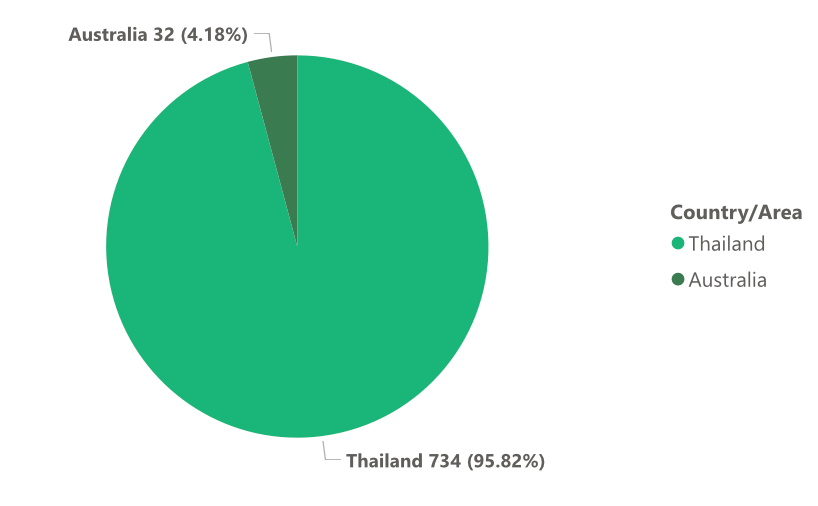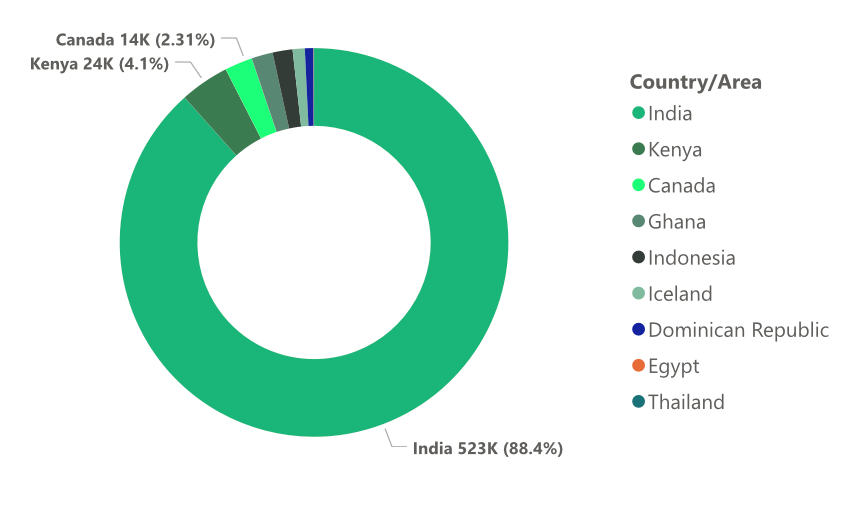Introduction to Plastic Credits
Plastic credits are a mechanism designed to incentivize and reward efforts in reducing plastic waste and promoting recycling. They represent one metric tonne of plastic waste that has been collected or recycled above baseline rates. Plastic credits are issued under the Plastic Program, which covers a wide range of activities related to waste management and recycling.
Examining the Current Supply of Plastic Credits

Figure 1: Existing Supply of Plastic Credits (Source: Calculus IQ)
The current supply of plastic credits stands at 766, as depicted in Figure 1. Thailand is the dominant supplier, contributing 95.82% of the total supply. Australia follows with a smaller share of 4.18%. These figures highlight the concentration of plastic credit supply in a few key regions, with Thailand emerging as the major player in the market.
Future Prospects: Plastic Credits in the Pipeline

Figure 2: Plastic credits in the pipeline (Source: Calculus IQ)
Looking ahead to the future, there is a substantial pipeline of plastic credits awaiting certification. The total number of plastic credits in the pipeline is 640,000, as shown in Figure 2. India has the largest share, accounting for 88.4% (523,000 credits). Kenya holds the second position with 4.1% (24,000 credits), and Canada follows closely with 2.31% (14,000 credits). These statistics indicate that India is poised to become a significant supplier of plastic credits in the future, emphasizing the country's commitment to addressing plastic waste.
Plastic Program and Certification Process
Projects developed under the Plastic Program undergo a rigorous assessment process to obtain certification. The program encompasses various activities aimed at tackling plastic waste, including waste collection from the environment, the development of new municipal infrastructure, the collection and sorting of recyclable plastic waste, and the advancement of recycling technologies.
Types of Plastic Credits
Two types of plastic credits are issued under the Plastic Program: Waste Collection Credits (WCCs) and Waste Recycling Credits (WRCs). Each credit represents one metric tonne of plastic waste that has been collected or recycled, respectively, above the baseline rates. These credits serve as a tangible measurement and reward for the positive impact made in reducing plastic pollution and promoting recycling.
Certification and Additional Labels
Plastic credits carry a unique serial number that distinguishes each credit. Additionally, they may be labeled with additional certifications to provide further information and transparency. These certifications can highlight specific aspects of the project, such as adherence to certain environmental standards or engagement in community initiatives related to plastic waste management.
The Future of Plastic Credits
The market for plastic credits shows promising growth potential as more countries and organizations recognize the importance of addressing plastic waste. With a significant number of plastic credits in the pipeline, particularly from India, it is expected that the future market will witness an increased supply of credits.
This expansion will provide opportunities for further investment, collaboration, and innovation in waste management and recycling initiatives globally.
Conclusion
Plastic credits play a crucial role in incentivizing and rewarding sustainable practices in waste management and recycling. With a clear certification process and two types of credits issued under the Plastic Program, they serve as a tangible representation of efforts to combat plastic pollution. The existing supply of plastic credits, led by Thailand, and the substantial pipeline of credits, predominantly from India, indicate a growing market for plastic credits.
This trend underscores the global commitment to reducing plastic waste and promoting a more sustainable future. As the market evolves, it is crucial to maintain transparency, integrity, and continuous improvement in the plastic credit system to maximize its positive impact on the environment. If you are interested in learning more about the voluntary carbon market, we invite you to interact with Calculus IQ. This tool can help you explore different aspects of the market, including project types, retirement volumes, and more.
![[object Object]](/lib_ubcXiSgTRmkLVyyT/k8w528b9mk1p20to.png?w=400)
